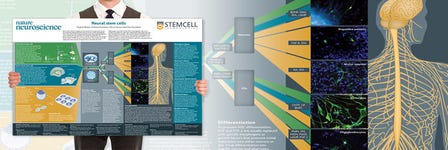How to Count Cell Spheres in Suspension Culture
A simple technique for counting spheres of cells that have been cultured in suspension, such as mammospheres, tumorspheres, or neurospheres
This protocol describes a simple technique for counting spheres of cells that have been cultured in suspension, such as mammospheres, tumorspheres, or neurospheres. In a sphere-formation assay for these cultures, each counted sphere represents a single stem or tumor cell that has been expanding. The sphere-formation efficiency of a culture (number of spheres divided by the number of seeded cells x 100) is a proxy for the self-renewal ability of that culture. The described enumeration method can also be used to count human pluripotent stem cell (hPSC) clumps grown in 3D suspension culture. The sphere counting procedure described below begins with cells cultured as spheres in a 6-well plate for suspension culture.
Materials
- 14 mL tube (e.g. Falcon® Round-Bottom Tubes, 14 mL, Catalog #38008)
- DMEM/F-12 with 15 mM HEPES (Catalog #36254)
- 96-well plate (e.g. Flat-Bottom Plates, Non-Treated, Catalog #38044)
Protocol
- Harvest the spheres from one well of a 6-well plate and transfer them to a 14 mL tube.
- Rinse the well with 2 mL of DMEM/F12 and combine with the collected suspension.
- Centrifuge at low speed, approximately 100 - 200 x g for 5 minutes.
- Carefully aspirate the supernatant, ensuring not to disturb the sphere pellet.
- Gently resuspend the pellet to a final volume of 500 μL with DMEM/F-12.
- Using a fine-tipped marker, divide one well of a 96-well plate into quadrants by drawing a plus sign on the underside of the well. The quadrants will help you keep track of which spheres have been counted.
- Add 50 μL of the sphere suspension to the well and view the spheres under the microscope.
- Count the spheres in each quadrant using a hand-tally counter. To ensure accuracy of the total sphere count, count at least 50 spheres in the well.
Notes:- If fewer than 50 spheres are present in 50 μL, gently mix the sphere suspension in the 14 mL tube to ensure even distribution. Repeat counting as per steps 7 and 8, using a larger volume.
- Counted spheres should be > 50 μm in diameter. Refer to Table 1 for more details.
- It is recommended to prevent aggregates from exceeding 400 μm. For more information, please see the Technical Manual for mTeSR™3D.
Table 1. Typical Sizes for Different Types of Cell Culture Spheres
TypeSizeNeurosphere100 μmMammospheres60 μmhPSC Clumps> 50 μm
- Calculate the Sphere Concentration by dividing the Sphere Count by the Counting Volume (e.g. 50 µL). Calculate the Total Sphere Count by multiplying the Sphere Concentration by the Total Volume (e.g. 500 µL).
Sphere Concentration = Sphere Count/Counting Volume (μL)
Total Sphere Count = Sphere Concentration x Total Volume
Note: Due to potential sphere and cell aggregation during culture, pelleting, and resuspension, this method provides only an estimate of the total number of spheres formed in culture.
Request Pricing
Thank you for your interest in this product. Please provide us with your contact information and your local representative will contact you with a customized quote. Where appropriate, they can also assist you with a(n):
Estimated delivery time for your area
Product sample or exclusive offer
In-lab demonstration



